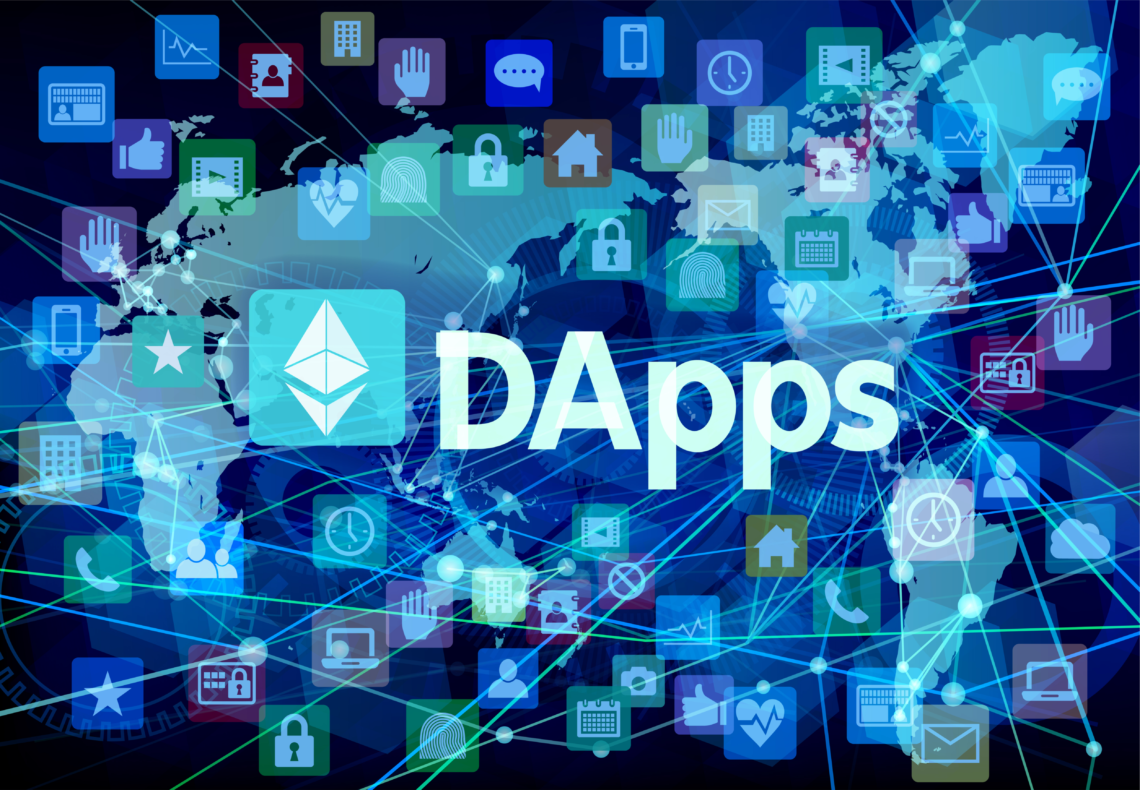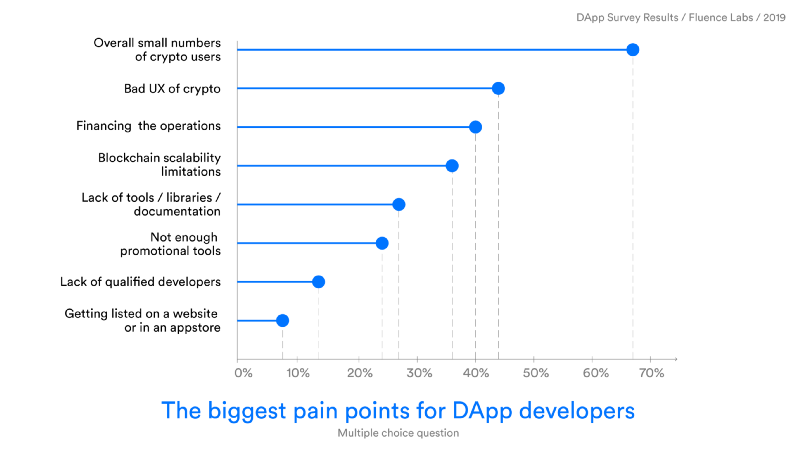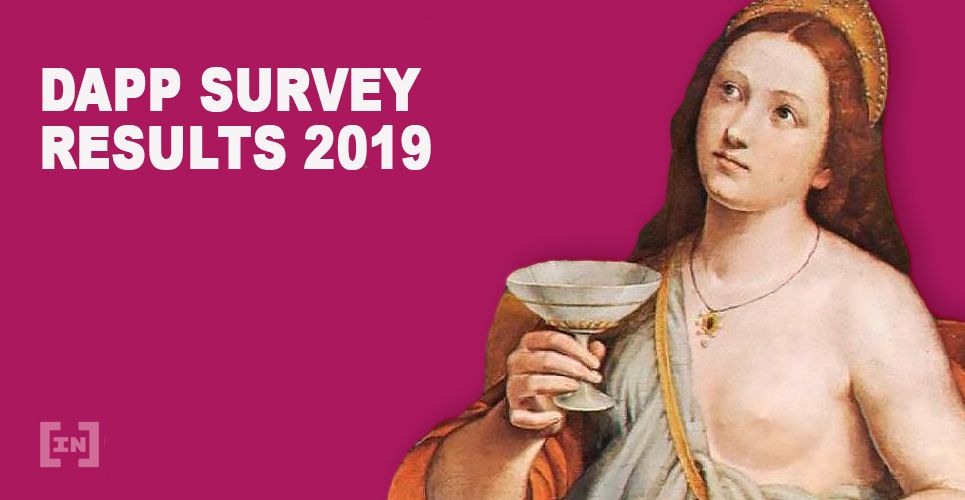On Jan 29, 2018, Evgeny Ponomarev, co-founder of Fluence.network, published the company’s “State of DApps Ecosystem, Technology, and Adoption 2019” report. It presents findings from a survey of spokespeople representing a variety of decentralized applications (dApps) developed between 2017 and 2018.
The report succeeds in examining a myriad of variables relevant to mass adoption and proper functionality of dApps. There are problems, however, with the limited definitions offered by Fluence.
While accounting for aspects of dApp technology that are considered centralized, the report does not highlight the importance of decentralization to decentralized applications. Nonetheless, this report manages to overcome many of the flaws in Dapp.com’s ‘dApp Market Report for 2018.’

Major Findings
Representatives of 160 dApps completed the survey. All were built using the Ethereum (ETH), EOS, or TRON (TRX) blockchains. 144 were built on just a single platform — 77 percent ETH, 12 percent on EOS, and 1 percent on TRX. Approximately 3 percent were built using both ETH and EOS, while another 3 percent were built using both ETH and TRX. The remaining dApps were built using all three blockchains. This means that 90 percent were built on one platform alone while 10 percent were built using at least two blockchains. Building on multiple blockchains enabled developers to increase scalability and node stability while avoiding backlogs and connectivity issues. Connectivity issues and node instability using ETH, EOS, or TRX alone was reported by multiple respondents as affecting overall dApp quality for the end user. Nearly two-thirds of those surveyed stated that there were plans in place to scale the dApp if the user base grew too large. The report highlighted, however, that scalability is not the biggest issue facing dApps. While 36 percent mentioned scalability as a problem, 67 percent stated that there was a limited number of users for the dApp in question. Furthermore, 44 percent reported that poor user experience was the biggest ‘pain.’
Overcoming Problems
Overcoming these problems may be accomplished using a number of different tactics. Educating the masses about crypto is one of the most important according to the report. Terms like ‘cryptocurrency, cryptoasset, ERC20 tokens, fungibility, and consensus algorithms’ may be understood within the crypto industry, but they have become jargon for those outside the industry. Teaching people what these and other crypto-related terms actually mean is integral to mass adoption of crypto. Another problem that the respondents discussed is users forgetting their passwords or private keys, as there is no simple ‘password key restore’ function currently available. The native privacy features of the blockchain will mean that creating a solution may not be as simple as it might sound. Developing an easy-to-use solution such as those implemented by most traditional apps may require novel innovations in blockchain-based technology.In the late 2018 we set out to investigate the state of DApp development. We’ve reached about 1600 DApps and talked to 160 developers. The results are finally here! 🎉https://t.co/Wvu2QHDtLa pic.twitter.com/ujYUJui0sZ
— Fluence Project (@fluence_project) January 29, 2019
Defining Decentralization
One problem with this report, however, is that it defines dApp without given full consideration to the term ‘decentralized application.’ It defines dApps according to two primary features: 1) The implementation of smart contracts as a key component, 2) A focus on the end user. There is no mention of decentralization in the definition. On the contrary, the report examines the centralized aspects of various dApps without fully discussing the problem of centralization to things that are named for their decentralized functionality. It is stated that over 50 percent of the dApps in the report use some form of centralized infrastructure. Nearly half used a centralized backend alone while databases, file storage, and authentication were also parts of dApp infrastructure which are commonly centralized. The report does not explain how a decentralized application can be qualified as such if it integrates a centralized infrastructure. If full infrastructural decentralization is a requirement, then a number of the dApps included in this survey must be excluded, as they would no longer meet the criteria of a dApp. However, if only partial decentralization is required, then the dApps included in the survey may qualify.
Merits of the Report
Despite the definition problem, the report appears a much stronger source of information than the 2018 market report released by Dapp.com. First, the report released by Fluence includes a methodology which explains how information was gathered and used. On the other hand, Dapp.com’s report included no methodology, which makes it difficult to determine where some of the information is being derived. Furthermore, Fluence lists all contributors to the survey as a manner of citing its sources. The report by Dapp.com, on the contrary, presented a great deal of supposed market information without citations. Lacking important information about references make the information presented overall difficult to verify and trust.Conclusion
There is a large amount of information within the 2019 ‘State of the DApps Ecosystem, Technology, and Adoption’ report published by Fluence. It highlights major impediments to the mass adoption of dApps while highlighting aspects of dApp infrastructure which is often centralized. However, the report does not fully discuss the role decentralization plays in classifying a dApp as such. Despite this difficulty, which appears easily remediable, the report appears a much stronger source of information about dApps than the 2018 Market Report released by Dapp.com last month. Do you think that Fluence’s ‘State of the DApps Ecosystem, Technology, and Adoption’ report will be helpful for the mass adoption of dApps? Let us know your thoughts in the comments below!Disclaimer
In adherence to the Trust Project guidelines, BeInCrypto is committed to unbiased, transparent reporting. This news article aims to provide accurate, timely information. However, readers are advised to verify facts independently and consult with a professional before making any decisions based on this content. Please note that our Terms and Conditions, Privacy Policy, and Disclaimers have been updated.

Alexander Fred
Global AI, Data Science, and Blockchain expert. Alexander writes for BeInCrypto where he completes technical analyses of various alt-coins and qualitative commentary and analysis about various cryptoassets and their potential for social integration.
Global AI, Data Science, and Blockchain expert. Alexander writes for BeInCrypto where he completes technical analyses of various alt-coins and qualitative commentary and analysis about various cryptoassets and their potential for social integration.
READ FULL BIO
Sponsored
Sponsored
